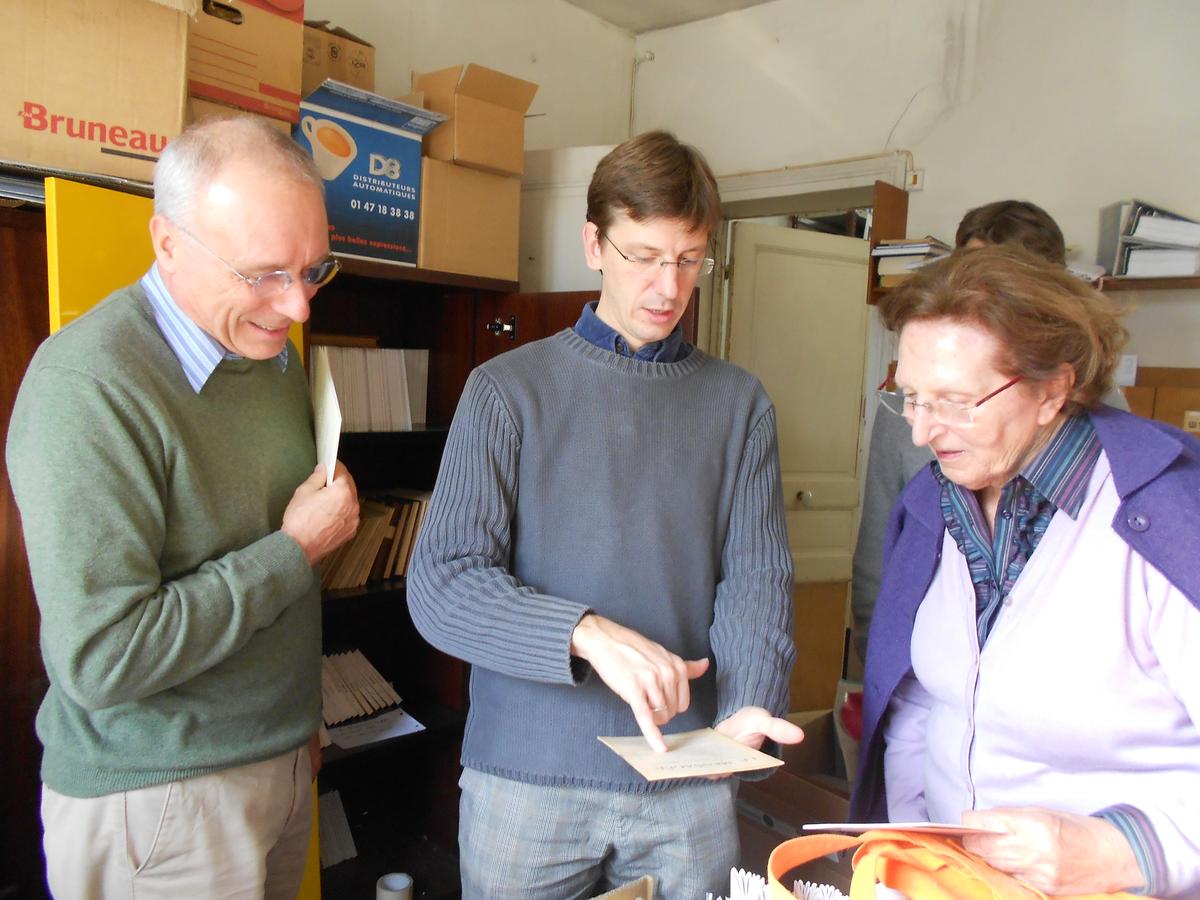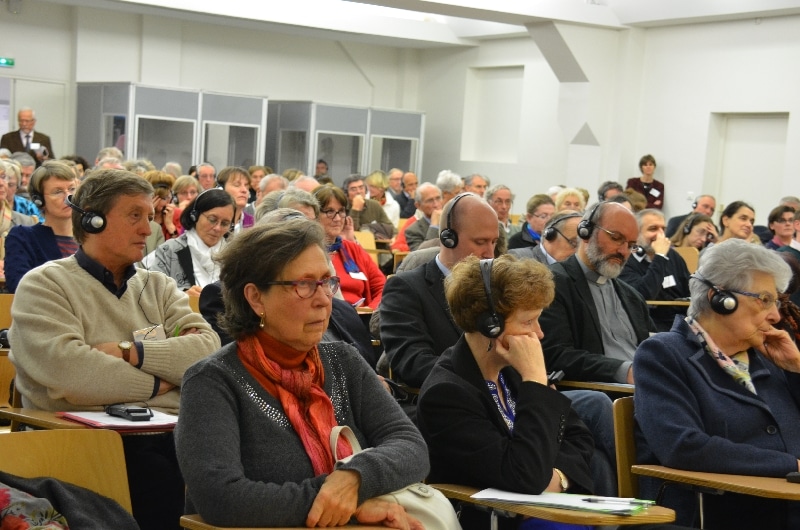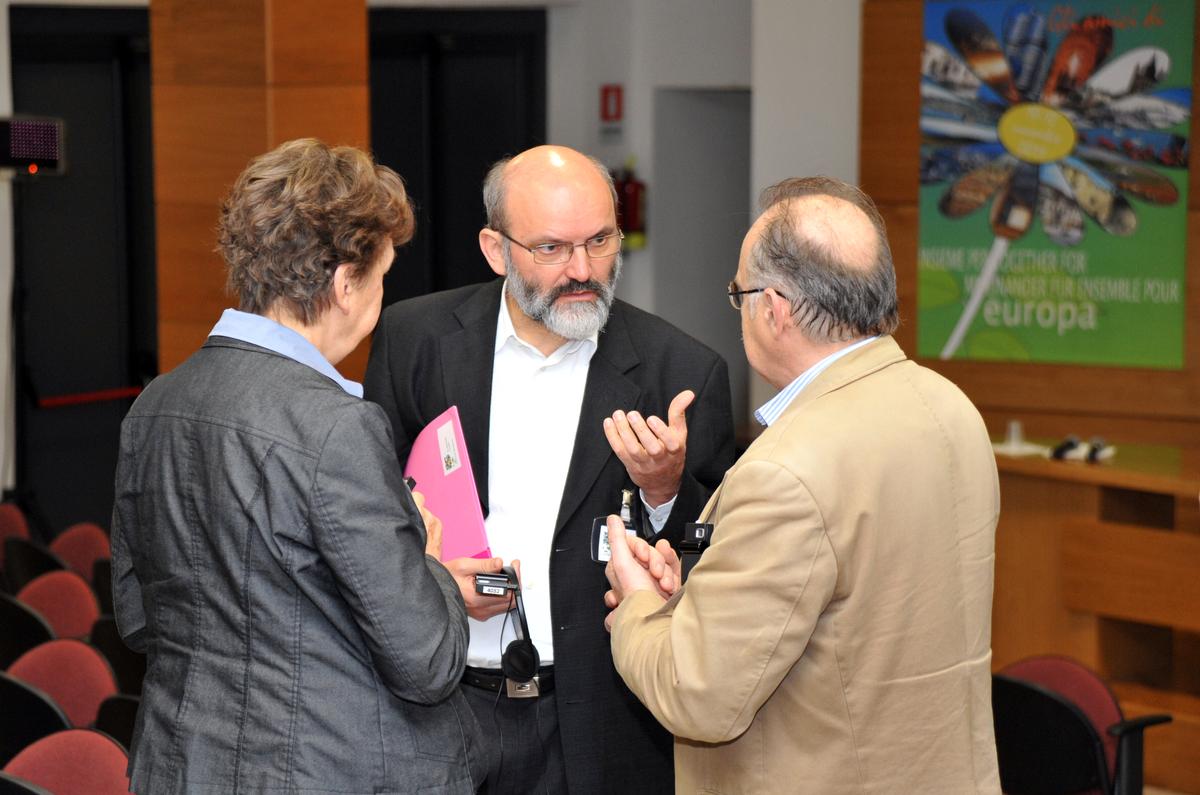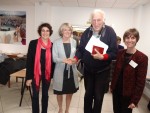
by Koni Brand | Nov 21, 2013 | News
During the annual meeting of the “Friends of Together for Europe” in Paris, on 6th November 2013 representatives of the Focolare Movement visited the headquarters of the Orthodox Movement, Acer-Mjo.
Spiritual trust, depth of sharing, discovery of a real friendship in Christ as a seed of a Christian European conscience; these are just a few of the fruits of the visit of representatives of the Focolare Movement to the headquarters of the Acer-MJO Movement (Russian Students’ Christian Action – Orthodox Youth Movement) in Paris. During the annual meeting of “Friends of Together for Europe” which took place on 7th-9th November in the French capital, Gabri Fallacara, Severin Schmid and Maria Wienken from Focolare, were received by Cyrille Sollogoub, President of the Orthodox association.
The Acer Movement was started in 1923 by some Russians who had been expelled from their country during the troubled years of the Revolution. The founders include such important personalities as Fr. Sergio Boulgakov, Fr. Giorgio Florovsky and Nicolas Berdiaev. The President, accompanied by his brother Igor who is responsible for the youth section, took us to the Church – Chapel , housed in a former garage in the courtyard, covered with glass. The Divine Liturgy has been celebrated here by famous Orthodox priests and theologians like Florovsky , Bulgakov and Alexander Men. Cyrille explained that “The icon that best expresses the charism of the Acer Movement is the presentation of Mary in the Temple: she contains Jesus and therefore she contains the Church. While in Russia, the churches were being destroyed and the Russian emigrants did not have the means to build others, a new understanding of what the Church is was born: not built from bricks but by living people, bearers of Christ and of his Church.” The aim of raising awareness, especially among the laity, of “being Church” is therefore at the origin of the Acer Movement which was approved by the Patriarch of Russia, Tikon, who was then assassinated; it depends juridically on the Patriarch of Constantinople.
The President recalled, “During the regime one of the main tasks of Acer was to print the Bible, spiritual and cultural literature and get it to Russia. It also supported thefamilies of dissidents and others in need.” Printing is still an important activity for Acer. The youth section is very active and involves over 200 young people. Despite the challenge of distance, summer camps are organized for them in the mountains, as an opportunity for re-evangelization; in this way the sense of faith and of belonging to the Church grows. Once trained, the young people get involved in their own parishes. This beautiful opportunity to meet and get to know one another left us with a sense of gratitude to God who brings us together in the world today with eyes of hope, open to a future of communion.
Gabri Fallacara

by Koni Brand | Nov 18, 2013 | 2013 - 2015 Friends
From 7th-9th November the “Friends” of “Together for Europe” gathered in Paris for their annual meeting. One hundred and twenty five leaders of 46 movements and communities of different Churches and 13 European countries – from Russia to Portugal , Denmark to Slovenia, were present at the meeting which took place in the historic setting of Montmartre.
The theme that had been chosen was: “Yes” to the poor and marginalized, as was expressed in the message of Stuttgart 2007.
The many contributions revealed how much the Communities and Movements are linked to the commitment to and with the most needy. It is not just acts of solidarity, but of friendship and brotherhood.
An intense moment was spent with Jean Vanier, founder of L’Arche Community. He opened the gift of his experience with these words: “Jesus says: “The kingdom of God is like a wedding feast” – but everyone is too busy – and the king who had issued the invitations sends his servants to seek the crippled and the lame in the hedgerows and at the crossroads – this is what I have tried to live in my life.” Jean Vanier is dedicated in particular to the mentally handicapped “the people most oppressed.” “They have changed me, I have seen that the Kingdom of God is theirs.” There are now 140 communities, ecumenical and interreligious, in which “fragile and strong” live together.
The prayers of Catholics and Evangelicals, which introduced the work of the first two days, were followed by that of the Russian Orthodox with its choir .
In the days of lively exchange on the path taken so far by Together for Europe, with the big events in Stuttgart 2004 and 2007 and in Brussels in 2012, thought was given to what could be the next step to take. Recalling the expression of Chiara Lubich, “the score is written in heaven” you could sense in the reciprocal listening to one another that the most valuable experience of this journey together is the deep communion that has developed between Movements of different churches. And it is precisely this “common witness of Christians” which has led to initiatives that Europe needs today, in the political and social fields, “so that the world may believe.”
At the same time, a further contribution is foreseen for 2016, in the form of a congress, which will probably take place in a city in Germany, in order to make visible the path of communion so far.
There was an solemn atmosphere when the new stage was entrusted to God in prayer and the commitment of mutual love renewed.
In May 2014, the Steering Committee will meet again in Dillingen in Germany to receive the prestigious “St. Ulrich European Award” which is 2014 has been awarded to “Together for Europe”.
In Paris there was also a chance to live the “culture of visiting each other”: we went to the Chapel of the metro station in Montparnasse, which is entrusted to the Community of Sant’Egidio , to pray together and learn about their work in the heart of Paris.
And even before the beginning of the meeting, there were those who went to meet the Emmanuel Community, founded by Pierre Goursat e Martine Laffitte-Catta, and those who visited the headquarters of Acer-Mjo (Russian Students’ Christian Action – Orthodox Youth Movement).
Gabri Fallacara

by Koni Brand | Jun 28, 2013 | 2013 - 2015 Friends
The Steering Committee of Together for Europe meets to reflect on future plans after the third international event: Together for Europe in May 2012.
The Committee made up of eight members including the Catholic, Orthodox and Evangelical-Lutheran Churches met at the Saint Egidio Community headquarters in Rome on 4thJune, 2013. The main purpose of this meeting was to discuss the fruits of the past year and try to understand together the next step to take. As Chiara Lubich liked to say, trying to see “the score written in heaven.”
In many of the 152 cities linked up on 12th May, 2012 a dynamic collaboration among local movements and communities of various Churches took place. In several countries, there is a national Together for Europe committee which acts as a network that continually encourages dialogue. Andrea Riccardi (founder of the Community of Saint Egidio), quoting Pope Francis, emphasized the responsibility to continue to go out and avoid being self-referential. It is the “culture of encounter” – emphasized Maria Voce, President of the Focolare Movement also quoting Pope Francis – “the culture of friendship and openness to others that we experience on this journey of communion that gives hope to our continent and beyond.” Returning from a trip to Germany, Maria Voce tells of meetings with important personalities who see Together for Europe as a way of uniting hearts.
Gerhard Pross, YMCA, told, how at the Catholic Academy of Stuttgart-Hohenheim, representatives of the Evangelical Church in Germany, the Catholic Church and other churches met, on the 23rd May, 2013 thanks to the invitation of some movements and communities connected with Together for Europe.
Nikolaus Schneider, Chair of EKD (Evangelical Church in Germany), Archbishop Robert Zollitsch (President of the German Bishops’ Conference), Bishop Gerhard Feige, the regional evangelical bishop Heinrich Bedford-Strohm and the Romanian Orthodox Metropolitan, Serafim, in their speeches, encouraged an open and intense exchange on ecumenical issues particularly timely for the 50th anniversary of the Second Vatican Council and in view of the 500th anniversary of the Reformation in 2017. Some topics emerged:
the return to Christ as the centre point of what unites us, the re-elaboration of our common history at a local and national level that show signs of reconciliation and the importance of raising awareness to the sensitivity of the other Churches.
Rev. Christophe D’Aloisio (SYNDESMOS) presented an interesting vision of some of the Orthodox communities in Europe.
The meeting had a full agenda.
Look at the “existential suburbs/outskirts”: this is one of the priorities.
On the morning of June 5th, cardinal Stanislaw Rylko, president of the Pontifical Council for the Laity met the Steering Committee of Together for Europe: he encouraged their projects.













































